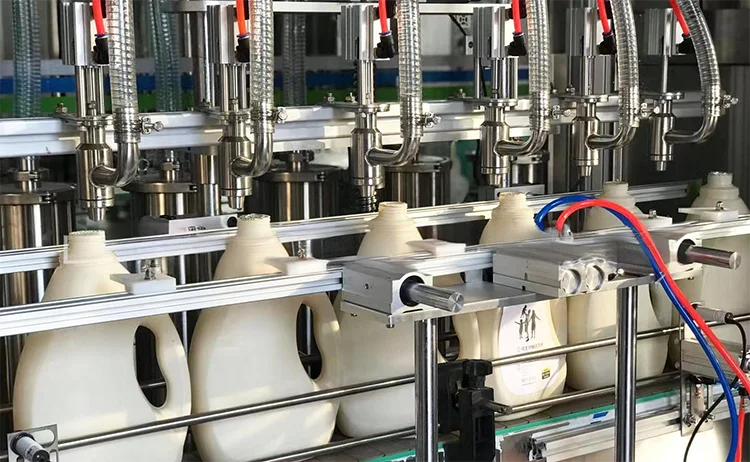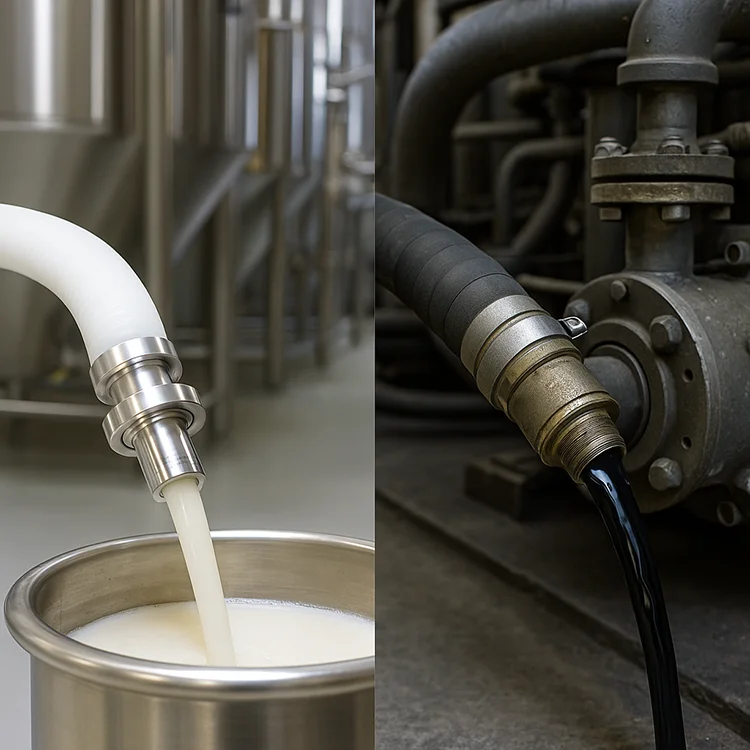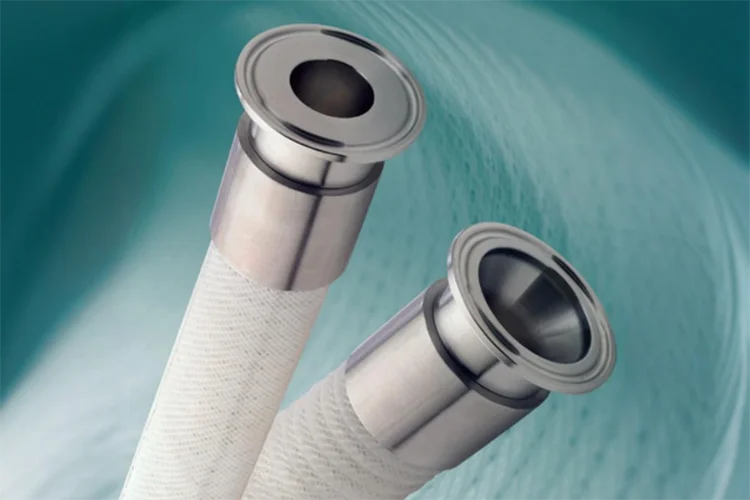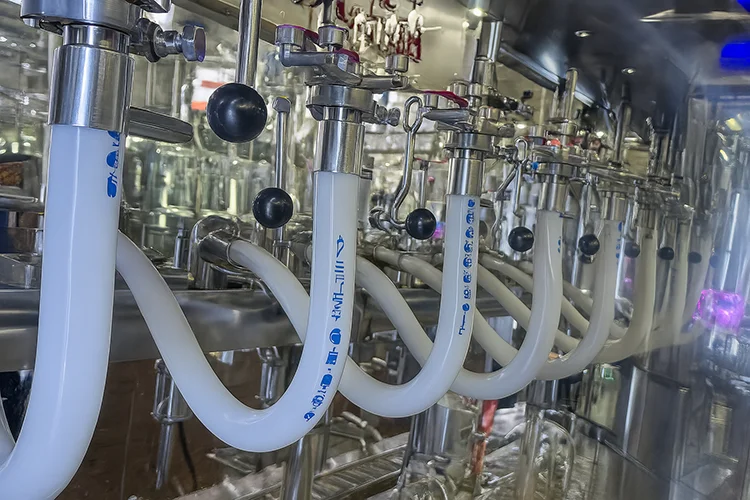Introduction
At Kinsoe, we’ve worked with countless clients across food & beverage, pharmaceutical, and industrial sectors, and I’ve seen one recurring mistake: assuming all hoses are created equal.
Imagine a brewery transferring its award-winning craft beer through a hose designed for oil. Or a dairy using industrial water hoses for milk processing. The result? Contaminated products, bacterial growth, and in worst cases—full product recalls.
This is why understanding the difference between FDA-approved food-grade hoses and standard industrial hoses is critical.
In this article, I’ll walk you through:
- What makes a hose food-grade
- How industrial hoses differ
- The certifications that matter
- Why using the wrong type can lead to costly consequences
- And how to choose the right hose for your specific application.
By the end, you’ll know exactly what sets these two categories apart and how to avoid the pitfalls many companies face.
What Are Food-Grade Hoses?
When we talk about food-grade hoses at Kinsoe, we’re referring to hoses that are specifically engineered for the safe transfer of consumable products—whether it’s milk in a dairy plant, beer in a brewery, or syrup in a confectionery factory. These aren’t just “cleaner” hoses. They’re built to meet strict standards that ensure hygiene, safety, and compliance with global food regulations.
🥛 Materials Designed for Safety
Food-grade hoses are made from materials that are non-toxic, odorless, and resistant to the kinds of contamination that can ruin food products. Common materials include:
- Silicone – Ideal for high-temperature applications and excellent for CIP (Clean-In-Place) systems.
- EPDM Rubber – Resistant to a wide range of food products and cleaning chemicals.
- PTFE (Teflon) – Inert and perfect for acidic or fatty foods.
- BPA-Free PVC – Lightweight and flexible for less demanding food transfer tasks.
These materials are carefully selected because they won’t leach harmful substances or impart off-flavors to the product being transferred.
🧼 Key Features of Food-Grade Hoses
Here’s what sets them apart:
- Smooth Inner Surfaces: Prevents microbial buildup and makes cleaning easier.
- Odor & Taste Neutrality: Ensures no transfer of smells or tastes to delicate products like wine or dairy.
- High Flexibility: Handles the constant movement and bending in food plants without cracking.
- Steam Cleanable: Many food-grade hoses withstand steam sterilization for effective sanitation.
🍺 Typical Applications
At Kinsoe, we’ve supplied food-grade hoses for:
✅ Breweries transferring beer and wort
✅ Dairies moving milk, cream, and yogurt
✅ Bakeries handling chocolate and sugary syrups
✅ Beverage plants bottling juices and soft drinks
These industries can’t risk contamination or non-compliance, and the right hose is their first line of defense.
What Are Industrial-Grade Hoses?
Unlike food-grade hoses, industrial-grade hoses are designed for a much broader range of applications where direct contact with consumables isn’t a concern. These hoses are the workhorses of manufacturing, construction, and mechanical systems, built to handle air, water, oil, chemicals, abrasives, and even slurries.
At Kinsoe, we’ve seen industrial hoses used everywhere from automotive plants to chemical processing facilities. While they excel in these demanding environments, they are not suitable for sanitary food or pharmaceutical applications.
Materials Built for Durability
Industrial hoses are made from rugged materials such as:
- Nitrile Rubber (NBR) – Resistant to oils and fuels.
- SBR (Styrene-Butadiene Rubber) – Great for water and air transfer.
- Reinforced PVC or rubber blends – Balances cost and strength.
- Wire-braided or textile reinforcements – Provides pressure resistance.
These materials are excellent for handling harsh chemicals, abrasive particles, or high-pressure applications but are not required to be food safe.
Key Features of Industrial-Grade Hoses
- Inner bores are often rougher, which can trap residues if used with consumables.
- Focused on abrasion and chemical resistance, not hygiene.
- Typically not certified for contact with food or drinking water.
- Designed for long service life in tough environments.
Typical Applications
Some common uses for industrial hoses include:
- Air and water delivery in factories
- Oil and fuel transfer in automotive workshops
- Chemical transfer in processing plants
- Dust collection and vacuum systems
They are engineered for performance and longevity, but without the stringent requirements that food and beverage industries demand.

Key Differences: Food-Grade vs. Industrial-Grade Hoses
At a glance, food-grade and industrial-grade hoses may look similar. But when you examine their construction, materials, and certifications, the differences become clear. Choosing the wrong type can compromise safety, regulatory compliance, and product quality.
Here’s a breakdown of the key differences:
Side-by-Side Comparison
| Feature | Food-Grade Hose | Industrial-Grade Hose |
|---|---|---|
| Material | FDA-approved, non-toxic (Silicone, PTFE, EPDM) | Nitrile, SBR, reinforced PVC, rubber blends |
| Certifications | FDA 21 CFR, EU 10/2011, NSF, 3-A Sanitary | Often ISO/EN standards, not food certified |
| Inner Surface | Smooth bore to prevent bacterial buildup | Rougher bore, may trap residues |
| Sanitation | Steam cleanable, resistant to CIP/SIP systems | Not designed for frequent cleaning cycles |
| Temperature Range | Wide range, supports extreme hot/cold cycles | Moderate range, varies with application |
| Cost | Higher due to stringent compliance standards | Lower, designed for general industrial use |
| Applications | Breweries, dairies, beverage plants, pharma | Factories, automotive, chemical transfer |
Why These Differences Matter
Food-grade hoses must meet strict hygiene standards because they come into direct contact with products people consume. Industrial hoses aren’t held to the same requirements, making them unsuitable for sanitary applications.
At Kinsoe, we often advise clients to avoid “making do” with industrial hoses for food use. The initial cost savings rarely offset the risks of contamination or regulatory violations.
Certifications and Compliance
When it comes to food-grade hoses, certifications aren’t just a nice-to-have—they’re mandatory. At Kinsoe, we always stress this point because certifications are the clearest way to verify that a hose is safe for use with consumables.
Food and beverage manufacturers operate under strict hygiene regulations worldwide. Using uncertified hoses can lead to failed audits, production shutdowns, or even product recalls. Let’s break down the key certifications that separate food-grade hoses from their industrial counterparts.
FDA (Food and Drug Administration) – United States
The FDA’s 21 CFR 177.2600 regulation sets standards for rubber articles intended for repeated use in food processing. Food-grade hoses certified under this standard are:
- Free from harmful leaching substances.
- Made with materials approved for direct food contact.
- Tested to prevent taste and odor transfer.
EU Regulation 10/2011 – Europe
This regulation governs plastic materials intended for food contact in the European Union. Hoses meeting this standard:
- Are compliant with migration limits for chemicals.
- Include a Declaration of Conformity from the manufacturer.
NSF International (NSF 51/61)
NSF 51 covers materials and components for food equipment, while NSF 61 applies to drinking water systems. Hoses with these certifications:
- Are tested for safety in potable water and food applications.
- Provide an extra layer of confidence for buyers in North America.
3-A Sanitary Standards
For dairy and other sensitive industries, 3-A Sanitary certification ensures that hoses meet stringent hygiene standards, with:
- Smooth, cleanable surfaces.
- Resistance to microbial growth.
What About Industrial-Grade Hoses?
Most industrial hoses do not carry these certifications. While they may comply with general standards like ISO 9001 for quality systems or EN standards for performance, they are not tested for food safety.
At Kinsoe, we’ve had customers in food production who initially used uncertified hoses and faced contamination issues during routine inspections. Switching to certified food-grade hoses not only solved the problem but also simplified their compliance reporting.
Why It Matters: Risks of Using the Wrong Hose
I’ve seen it happen too many times—companies trying to save on costs by using standard industrial hoses in food or beverage operations. On the surface, it may seem like a harmless decision. But the risks involved are far greater than most realize.
Here’s why this shortcut can turn into a major liability.
Contamination Risks
Industrial hoses often have rougher inner surfaces, which can trap food particles and foster bacterial growth. These hidden contaminants may not show up immediately but can cause:
- Sour flavors or off-odors in products like beer or milk.
- Mold and bacterial colonies in soft drink lines.
- Allergens lingering in hoses between production runs.
Unlike food-grade hoses, industrial hoses are not designed for frequent cleaning or steam sterilization, making them a poor fit for sanitary systems.
Regulatory Non-Compliance
Using a non-certified hose in a food facility is a direct violation of FDA, EU, or NSF regulations. The consequences can include:
- Failed inspections by regulatory bodies.
- Production halts until compliant equipment is installed.
- Fines or loss of operating licenses.
Hose Degradation and Failure
Industrial hoses are not built to withstand the harsh cleaning chemicals and high temperatures often used in food and beverage processing. Over time, this can lead to:
- Cracks or swelling in the hose walls.
- Leaching of chemicals or particles into food products.
- Sudden hose failures causing downtime and product loss.
Financial and Reputational Damage
A single recall or contamination incident can damage your brand’s reputation and cost thousands—or even millions—in losses. At Kinsoe, we’ve worked with companies that had to discard entire production batches because an uncertified hose failed.
The cost of choosing a proper food-grade hose upfront is minimal compared to the cost of fixing these mistakes later.
Choosing the Right Hose for Your Application
At Kinsoe, we believe selecting the right hose is not just about meeting technical specifications—it’s about protecting your product, your process, and your reputation. Whether you’re handling food, beverages, or industrial fluids, the decision should be informed by a clear understanding of your application’s demands.
For Food and Beverage Applications
If your hose will come into contact with consumables, here’s what to consider:
- Material Compatibility
- Match the hose material to the type of food or beverage.
- Silicone and PTFE are excellent for acidic or high-temperature products.
- EPDM works well with dairy and water-based liquids.
- Certification Verification
- Look for FDA 21 CFR, EU 10/2011, NSF 51/61, and 3-A Sanitary markings.
- Always request a Declaration of Conformity from your supplier.
- Cleaning and Sterilization Needs
- Choose hoses that can handle CIP (Clean-in-Place) or SIP (Steam-in-Place) systems.
- Smooth inner bores are essential for quick, thorough cleaning.
- Flexibility and Durability
- Ensure the hose can endure repeated bending without kinking or cracking.
- Consider reinforcement layers for high-pressure applications.
For Industrial Applications
If the hose is for transferring air, water, oil, or chemicals:
- Resistance Requirements
- Check for abrasion, oil, or chemical resistance as needed.
- Reinforced rubber or PVC blends often perform well.
- Temperature and Pressure Ratings
- Match these to your system’s operating conditions.
- Remember: industrial hoses often have narrower temperature ranges.
- Cost vs. Performance Balance
- Industrial-grade hoses are usually more affordable but avoid using them in food environments.
Kinsoe Tip: Don’t Cut Corners
We’ve helped customers who learned this lesson the hard way. One beverage producer came to us after their uncertified hose degraded, causing flavor contamination in several batches. By switching to our FDA-approved silicone hoses, they not only avoided future incidents but also passed their next audit without a single note.
The key takeaway? Upfront investment in the right hose saves far more in the long run.
![]()
Conclusion
Choosing between food-grade and industrial-grade hoses isn’t just a technical decision—it’s a business-critical one. At Kinsoe, we’ve seen first-hand how the right hose protects product quality, ensures compliance, and keeps operations running smoothly.
Food-grade hoses are purpose-built to handle the unique challenges of sanitary environments. With their smooth bores, FDA and EU certifications, and resistance to cleaning cycles, they’re the clear choice for breweries, dairies, and beverage plants. Industrial hoses, on the other hand, excel in rugged environments like chemical plants, construction sites, and mechanical systems but should never be used where hygiene is paramount.
The cost of getting it wrong is high—contaminated products, regulatory fines, damaged reputations, and lost revenue. The cost of getting it right? A well-chosen, properly certified hose that pays for itself in peace of mind and long-term reliability.
At Kinsoe, we specialize in supplying FDA-approved, food-safe hoses tailored to your application. Whether you’re upgrading your production line or specifying hoses for a new facility, our team can help you choose a solution that meets the highest standards for safety and performance.
Don’t wait for a failed audit or product recall to make the switch. Contact us today to discuss your needs and discover how Kinsoe’s hose solutions can keep your operation clean, compliant, and efficient.



